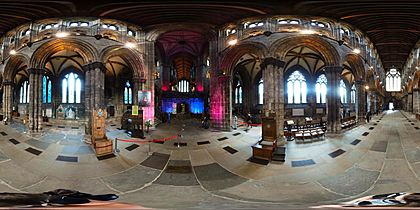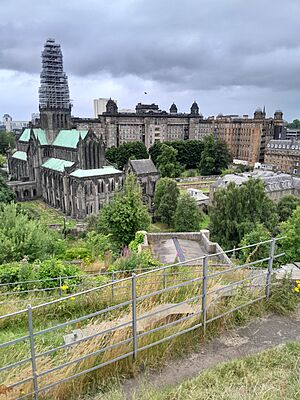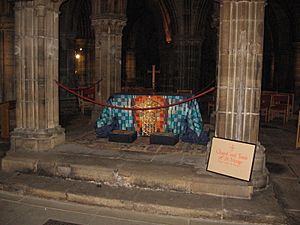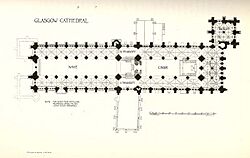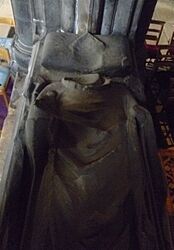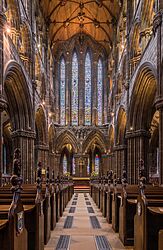Glasgow Cathedral facts for kids
Quick facts for kids Glasgow Cathedral |
|
|---|---|
| High Kirk of Glasgow St Kentigern's Cathedral St Mungo's Cathedral |
|
|
Cathair-eaglais Ghlaschu
|
|
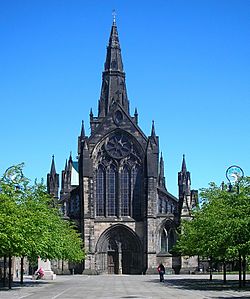
The west front of Glasgow Cathedral, from Cathedral Square
|
|
| 55°51′47″N 4°14′05″W / 55.8630°N 4.2346°W | |
| Location | Castle Street, Townhead, Glasgow G4 0QZ |
| Country | Scotland |
| Denomination | Church of Scotland |
| Previous denomination | Roman Catholic |
| History | |
| Status | Parish church |
| Founded | 12th century |
| Dedication | Saint Mungo |
| Consecrated | 1197 |
| Past bishop(s) | Archbishop of Glasgow |
| Architecture | |
| Functional status | Active |
| Heritage designation | Category A listed building |
| Designated | 15 December 1970 |
| Style | Gothic |
| Specifications | |
| Length | 285 feet (87 metres) |
| Width | 65 feet (20 metres) |
| Height | 105 feet (32 metres) |
| Spire height | 225 feet (68 metres) |
| Administration | |
| Presbytery | Glasgow |
Glasgow Cathedral (in Scottish Gaelic: Cathair-eaglais Ghlaschu) is a very old church in Glasgow, Scotland. It belongs to the Church of Scotland. This cathedral is the oldest one on mainland Scotland and the oldest building in Glasgow.
For a long time, until the 1500s, Glasgow Cathedral was the main church for the Archbishop of Glasgow. It is one of only two medieval cathedrals in Scotland that survived the Scottish Reformation almost completely. The old Bishop's Castle used to stand near the cathedral until 1789. Today, the cathedral and the nearby Necropolis (a large cemetery) are seen as their own special area in the city.
The cathedral is named after Saint Mungo, who is the patron saint of Glasgow. His tomb is located in the Lower Church of the building. The first stone cathedral was opened in 1136. Parts of this first building have been found under the current one. The cathedral we see today was officially opened in 1197. However, much of what you see now was built during a big reconstruction in the 1200s.
After the University of Glasgow was founded in 1451, its first classes were held inside the cathedral's chapter house. After the Reformation, the cathedral was divided inside to serve three different church groups. By the early 1800s, people started to really appreciate the cathedral's old architecture. By 1835, the other two church groups had moved out. This allowed the cathedral to be restored to look more like it did in its early days.
Since 1587, Glasgow Cathedral has been owned by the Crown (the government). In 1857, the entire building was put under the care of the state. Today, Historic Environment Scotland looks after it. The church group that meets there is part of the Church of Scotland's Presbytery of Glasgow.
Contents
Exploring the Cathedral's Past
Early Beginnings
The story of Glasgow Cathedral is closely connected to the city itself. In the 500s, it is believed that Saint Mungo brought the body of a holy man named Fergus to be buried at a place called Cathures. This place later became known as Glasgow. Some say that Saint Ninian blessed this burial ground in the 400s.
Saint Mungo built a small church here and was buried in it in 614. His burial place in the Lower Church became a very important spot for pilgrimage in the Middle Ages. We don't know much about these first churches, but they were likely made of wood and wattle (woven branches).
The first stone cathedral was built on a hill above the Molendinar Burn. This project started when King David I decided to create a bishopric (a bishop's area) in Glasgow. The new cathedral was opened in 1136. It was built over Saint Mungo's burial site, which might explain why it's on a hillside. The building slowly grew over about 150 years.
During excavations between 1988 and 1997, parts of this first stone cathedral were found under the current one. In 1175, Pope Alexander III declared Glasgow a "special daughter" of Rome. This meant the diocese was free from the control of the Archbishop of York. Around the same time, Glasgow was given special trading rights by King William I.
Medieval Building and Changes
The first cathedral was damaged or destroyed by fire. The current cathedral was then started and officially opened in 1197. Between 1207 and 1232, Bishop Walter Capellanus began a building project. This included finishing the choir and the Lower Church. It also set the plan for the transepts and nave.
From 1233 to 1258, Bishop William de Bondington continued the rebuilding. He added a longer eastern part to create a shrine for Saint Mungo at the main level. He also added three extensions: the chapter house, the sacristy (a room for church items), and what is now the Blacader Aisle. Building continued through the 1200s, including the central tower and spire.
Edward I of England visited the cathedral in 1301 during the First War of Scottish Independence. He made offerings at the high altar and Saint Mungo's tomb. In 1306, after John Comyn was killed, Robert the Bruce came to Glasgow. He met with Bishop Robert Wishart, who was known as the "warrior" Bishop. Wishart forgave Bruce and encouraged the clergy to support him. Wishart even used timber meant for cathedral repairs to build siege engines for battles. After his death in 1316, Bishop Wishart was buried in the Lower Church. His tomb has an effigy (a statue) whose head was damaged, likely during the Reformation.
In 1406, lightning caused a lot of damage, including to the wooden steeple. Bishops William de Lauder, John Cameron, and William Turnbull rebuilt the central tower, spire, and chapter house. Bishop Turnbull was very important in starting the University of Glasgow. He asked King James II to write to the Pope to ask for a university in Glasgow. The Pope agreed in 1451, creating a new university for teaching many subjects. The Bishops of Glasgow were the leaders of the new university. Its first classes were held in the cathedral's chapter house.
By the 1400s, the cathedral was part of a large walled area called the chanonry. This area included the Bishop's Castle and homes for church officials. Most of this was cleared away after the Scottish Reformation in 1560. The only building still standing today from that time is the Provand's Lordship. In 1492, the Pope made Glasgow a higher-ranking archbishopric. King James IV signed a peace treaty with England at the high altar in 1502. The cathedral and nearby castle were also involved in battles in 1544 and 1560.
The Reformation and Beyond
The Scottish Reformation in 1560 led to big changes. Archbishop James Beaton fled to France, taking church records with him. Glasgow Cathedral was "cleaned" of its Catholic items like altars and statues. It was decided to keep the building for Protestant worship. In 1562, David Wemyss became the first Protestant minister of Glasgow Cathedral.
The building suffered from damage and theft. By 1574, it was in such bad shape that the Glasgow town council had to act. They raised money for repairs, but it took years to fix the cathedral and change it for presbyterian worship. Many windows were bricked up. In 1579, local trade groups helped protect the cathedral from more damage, which is why it survived the Reformation quite well. In 1581, King James VI gave money to Glasgow town for the cathedral's upkeep.
Eventually, the cathedral housed three different church groups. In 1587, the Outer High Church started meeting in the nave. In 1595, the Barony Church group was created and met in the Lower Church. In 1635, the choir area became the High Church, or Inner High Church.
In November 1638, the General Assembly of the Church of Scotland met in the cathedral. This meeting was controlled by the Covenanters. They cancelled past decisions that had been influenced by the King and bishops. They also got rid of bishops in the Church of Scotland and confirmed the Assembly's right to meet every year.
18th and 19th Century Restorations
In 1798, the Lower Church stopped being used for worship and became a burial place. This involved adding about a metre of earth over the floor. During the 1700s and 1800s, several memorials were put up for wealthy Glasgow merchants who had made their fortunes. Some of these memorials have since been removed due to changing public views.
By the 1830s, people started to truly appreciate the cathedral's old architecture. This led to detailed drawings and plans for restoration. By 1835, the Outer High Kirk and Barony Kirk groups had moved out. This left the Inner High Kirk as the only congregation in the cathedral. In 1843, the graves were removed from the Lower Church. The original floor levels were restored, and windows were opened up as part of the restoration.
The 1840s also saw the removal of two towers at the west front. One tower was the cathedral's bell tower until the central tower was finished. The other tower held church records and courts. People mistakenly thought these towers were not very old and blocked the view of the main entrance. The towers were taken down in 1846 and 1848. Because of a lack of money, new towers were not built. Instead, the current nave aisles were created. In 1857, the entire cathedral building was put under the care of the state.
In the 1860s, the windows in the nave and choir were replaced with beautiful stained glass from Munich. This was one of the biggest public art projects of that time. In 1879, a large organ was installed. This was the first organ in the cathedral since the Reformation. In 1849, Queen Victoria and Prince Albert visited the cathedral.
A significant book about the cathedral's history, called The Book of Glasgow Cathedral, was published in 1898.
20th Century to Today
Between 1909 and 1912, the old wooden roofs over the choir and nave were replaced with new oak roofs. This was because the old ones were unsafe. The new roof was made lighter by using copper sheeting instead of lead and slate. The distinctive green copper roof you see today dates from this time.
By 1938, the colours of the "Munich Glass" windows had faded. The Society of Friends of Glasgow Cathedral decided to replace them with new works by the best artists of the time.
Queen Elizabeth The Queen Mother unveiled a new window in 1954. It was a memorial to those who died from the four Scottish divisions in World War I and World War II.
In 1971, a memorial service was held in Glasgow Cathedral after the Ibrox Stadium disaster. This tragic event claimed the lives of 66 football fans.
The funeral of Scotland's First Minister Donald Dewar was held in the cathedral in October 2000.
Elizabeth II attended special services at Glasgow Cathedral to celebrate her Silver Jubilee in 1977 and her Diamond Jubilee in 2012.
-
Defaced effigy on the tomb of Bishop Robert Wishart
The Great Bell
The cathedral's large bell is now on display on the floor of the cathedral. It is an interesting object to see. Its inscription says it was first made in Holland in 1583. It was paid for by Marcus Knox, a Glasgow merchant. The bell broke in 1778 and was recast (remade) in London in 1790.
Music at the Cathedral
The Glasgow Cathedral Choir is made up of professional adult singers. They perform at the two regular Sunday services each week. The current director of music is Andrew Forbes. The cathedral organist is Malcolm Sim. The large four-manual organ was installed in 1879. It has been maintained by Harrison & Harrison since they rebuilt it in 1996.
Important Burials
Inside the Cathedral
- James Boyd, Archbishop of Glasgow (1573–1581)
- Gavin Dunbar, Archbishop (1524–1547)
- James Law, Archbishop (1615–1632)
- Saint Mungo, founder and patron saint of Glasgow
- Robert Wishart, Bishop of Glasgow (1271–1316)
Old Burial Ground (Cemetery)
- Charles Macintosh (1766–1843), a famous chemist and inventor.
- Peter Lowe (c.1550-1610), a surgeon.
Images for kids
See also
 In Spanish: Catedral de Glasgow para niños
In Spanish: Catedral de Glasgow para niños



